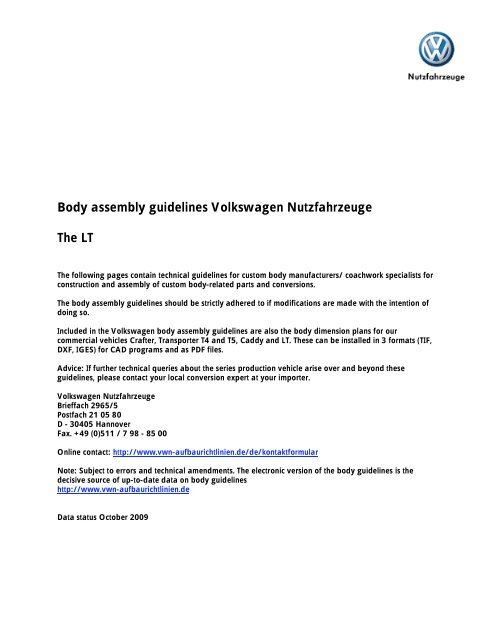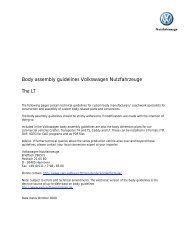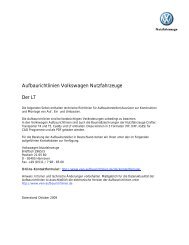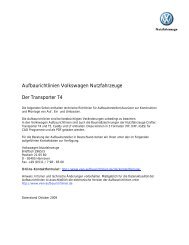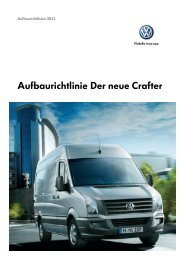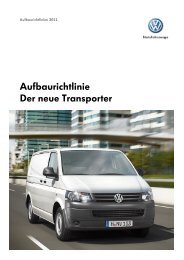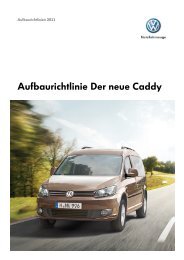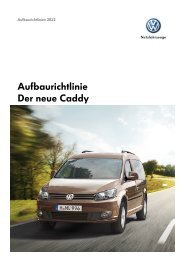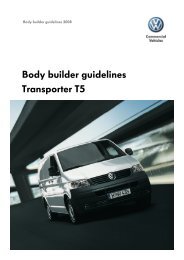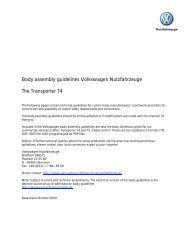Body assembly guidelines Volkswagen ... - Aufbaurichtlinien
Body assembly guidelines Volkswagen ... - Aufbaurichtlinien
Body assembly guidelines Volkswagen ... - Aufbaurichtlinien
You also want an ePaper? Increase the reach of your titles
YUMPU automatically turns print PDFs into web optimized ePapers that Google loves.
<strong>Body</strong> <strong>assembly</strong> <strong>guidelines</strong> <strong>Volkswagen</strong> Nutzfahrzeuge<br />
The LT<br />
The following pages contain technical <strong>guidelines</strong> for custom body manufacturers/ coachwork specialists for<br />
construction and <strong>assembly</strong> of custom body-related parts and conversions.<br />
The body <strong>assembly</strong> <strong>guidelines</strong> should be strictly adhered to if modifications are made with the intention of<br />
doing so.<br />
Included in the <strong>Volkswagen</strong> body <strong>assembly</strong> <strong>guidelines</strong> are also the body dimension plans for our<br />
commercial vehicles Crafter, Transporter T4 and T5, Caddy and LT. These can be installed in 3 formats (TIF,<br />
DXF, IGES) for CAD programs and as PDF files.<br />
Advice: If further technical queries about the series production vehicle arise over and beyond these<br />
<strong>guidelines</strong>, please contact your local conversion expert at your importer.<br />
<strong>Volkswagen</strong> Nutzfahrzeuge<br />
Brieffach 2965/5<br />
Postfach 21 05 80<br />
D - 30405 Hannover<br />
Fax. +49 (0)511 / 7 98 - 85 00<br />
Online contact: http://www.vwn-aufbaurichtlinien.de/de/kontaktformular<br />
Note: Subject to errors and technical amendments. The electronic version of the body <strong>guidelines</strong> is the<br />
decisive source of up-to-date data on body <strong>guidelines</strong><br />
http://www.vwn-aufbaurichtlinien.de<br />
Data status October 2009
General information<br />
It is not permitted to modify spring characteristics, brake system and steering unit. Exceptions must be approved by<br />
<strong>Volkswagen</strong> AG before the modification is carried out.<br />
Note:<br />
Changing the steering and braking forces for vehicle conversions for disabled persons is not possible.<br />
Airbag<br />
If the attachment manufacturers modify the structure of the vehicle, e. g.<br />
• modifications of the front section of the vehicle<br />
• mounting of belt retractors if the B-pillars are left out<br />
• modifications of the floor structure in the area of the airbag trip device<br />
• modifications of the seats, resulting in altered kinematics of the passengers<br />
• modifications of the airbag-system cabling<br />
• modifications of the system design<br />
the safe functioning of airbag and belt retractor can no longer be guaranteed. These component parts may only be used<br />
after having been approved by <strong>Volkswagen</strong> AG.<br />
Emission behaviour (exhaust gas/noise)<br />
If parts are to be modified that are producing exhaust gas and noise (e. g. engine/injection pump/control unit, exhaust<br />
system/catalytic converter, air suction installation, tyres, etc.), it is required to perform exhaust gas and noise<br />
measurements. It is also necessary to adhere to the current versions of the specific national directives and regulations.<br />
For this reason, parts which are installed as standard to reduce emissions should not be removed or changed. Otherwise<br />
the license may expire.<br />
Note: Subject to errors and technical amendments. The electronic version of the body <strong>guidelines</strong> is the decisive source of up-to-date data on body <strong>guidelines</strong> (online body<br />
<strong>guidelines</strong>). Data status August 2007
The company Paulisch GmbH & Co. KG<br />
Eisenbahnstraße 17<br />
Postfach [P.O. box] 1405<br />
97804 Lohr am Main, Germany<br />
Phone +49-9352-855260<br />
Fax +49-9352-855102<br />
is our supplier of serial seats for the passenger compartment. This firm is also offering two seat variants which can be<br />
positioned against the driving direction without changing the standard seat mounting points in the 1st row of seats. This<br />
applies to the narrow triple seat and the double seat. Since we do not supply these seat variants, it is only possible to<br />
order them directly from this manufacturer. These seats are already provided with (automatic) lap belts. The pre-cut fabric<br />
covering material reference allows for the omission of the three-point belts!<br />
Prices: State 21 November, 1997:<br />
• Narrow triple seat based on standard seat, with upper part turned by 180° and with the seat mating-part sets,<br />
including the installation materials for the vehicle floor, excluding head restraints. DEM 1292/piece (without<br />
turnover tax)<br />
• Double seat, as above, DEM 968/piece (without turnover tax)<br />
The prices are ex-works from Lohr am Main, Germany, excluding packaging.<br />
The head restraints can be ordered as replacement parts from <strong>Volkswagen</strong> using Part No. 2D0 881 901... The nav_side<br />
missing here depends on the selected seat cover.<br />
Note:<br />
Since the floor attachment for the above mentioned seat variants are taken over from the standard seat variants without<br />
modifications, it is possible to replace the above mentioned seat variants by the corresponding standard seat variants, if<br />
the backrest locking at the side panel, which is required for this, was appropriately retrofitted according to the series<br />
specifications.<br />
Note: Subject to errors and technical amendments. The electronic version of the body <strong>guidelines</strong> is the decisive source of up-to-date data on body <strong>guidelines</strong> (online body<br />
<strong>guidelines</strong>). Data status August 2007
At the multi-purpose/box-type delivery van, attachment and base group form a self-supporting unit. Supporting parts of this<br />
self-supporting unit must not be removed without being replaced by another component. Baffles have no supporting<br />
function. Modifications, even the complete removal, are permitted. If car-body parts are to be modified or to be installed, it<br />
is only permitted to weld if bonding is not possible.<br />
• Cut-outs in the side wall<br />
If profiles are cut in order to install cut-outs (windows, doors, bonnets, ventilation, air exhaust, etc.), the cut-outs<br />
must be reinforced by an enclosing frame and must be welded to the cut profiles.<br />
• Roof heightening (plastic roof)<br />
refer to item 3.6, Roof design<br />
At closed bodies with partition walls ventilation slots are located in the partition wall and the D-pillars. At car modifications<br />
it is only allowed to cover these ventilation slots, if new slots are produced in the cab instead. For example in the cab<br />
doors.<br />
Note: Subject to errors and technical amendments. The electronic version of the body <strong>guidelines</strong> is the decisive source of up-to-date data on body <strong>guidelines</strong> (online body<br />
<strong>guidelines</strong>). Data status August 2007
If the wheel base is to be modified or if the overhang is to be extended, the material quality and dimensions of the<br />
lengthening piece must correspond to the chassis frame (St 12.03). Functioning, smoothness and free movement of<br />
instruments and operating equipment as well as the stability of supporting parts must not be impaired by the performed<br />
modifications.<br />
Cut-outs in the backwall of the driver s cab must be provided with an enclosing frame. The remaining diagonal struts and<br />
cross-beams are to be reinforced by junction plates and are to be welded to the inserted frame.<br />
The distance between cab and attachment must be at least 50 mm.<br />
Frame modifications<br />
• The permitted axle loads must not be exceeded. It is also required not to fall below the permitted minimum front<br />
axle load.<br />
• Attach the underrun protection as explained for standard vehicles.<br />
• Extend the subframe up to the frame end.<br />
• Check the function of the towing device.<br />
• Reinforcements must be available for desired towing device.<br />
The side rails are hollow profiles (cap profiles). If it is required to drill, the appropriate operations may only be performed in<br />
the specified areas.<br />
It is not permitted to drill:<br />
• At the upper and lower belt of the chassis frame. Exceptions are boreholes at the rear frame end. However,<br />
these boreholes must not lie in the area that are reserved for the supporting functions of the rear axle. In addition,<br />
they must not be applied to parts that are attached to the frame.<br />
• In the range of profile modifications of the frame side-rails (frame drop and frame indent).<br />
• At force-application points (e.g. directly at the spring brackets).<br />
In special cases, it is permitted to drill boreholes in the crosspiece of the frame side rails.<br />
• Distance a: at least 20% of the frame height<br />
• Hole separation b: at least 50 mm<br />
• max. bore diameter: 15 mm<br />
Grind and ream after drilling. Before usage, distance bushes must be welded in.
According to item 2.3, the permitted maximum rear overhangs (depending on wheel base and permitted total<br />
weight) are to be kept.<br />
For this purpose, consider the following instructions:<br />
• If the frame is to be extended by more than 350 mm, an additional cross member is to be installed.<br />
• It is required to check the permitted trailing load (according to the vehicle registration document). Reduce,<br />
if necessary.<br />
• Overhang extension according to the illustration.<br />
As an ex-works preparation, the SBBR line can be installed with a spare section of 700 mm. Ordering options can<br />
be taken from the sales documents.<br />
LT46<br />
LT28<br />
/<br />
LT35
Perform wheel-base extensions of the longest standard base. If the wheel base is to be modified, the next larger standard<br />
wheel-base is to be used and shortened. Reinforce the intersecting point with sheet-metal shoes.<br />
Wheel-base modifications based on displacing the rear axle are not permitted.<br />
Separation points are not permitted in the area of:<br />
• Force-application points<br />
• Axle guiding and axle spring-suspension<br />
• Profile modifications<br />
After the wheel base modification, the chassis has to be reinforced by a continuous subframe.<br />
Moments of resistance required for the subframe:<br />
Up to the max. standard wheel-base: 30 cm3 •<br />
.<br />
• Above the max. standard wheel-base: 15% increase.<br />
The wheel-base modification results in an altered turning circle and changed weight values.<br />
Wheel base modifications lying within the range of the minimum/maximum standard wheel-base, require no special<br />
permission.<br />
Drive shafts<br />
• If wheel-base modifications are to be performed, the drive-shaft arrangement and length must correspond to that<br />
of a comparable standard vehicle.<br />
• The diameter and wall-thickness of the drive-shaft must correspond to that of the standard vehicle.<br />
• If required, use several drive shafts with intermediate bearings.<br />
• The inflection angles (ß1 = ß2) must not exceed 6° . Deviations impair operating life and noise<br />
level.<br />
•<br />
Counterbalance drive shafts before mounting them.
<strong>Volkswagen</strong> AG does not provide information on the road/braking/steering behaviour of vehicles whose wheel bases were<br />
extremely changed.<br />
Inflection types<br />
Note: Subject to errors and technical amendments. The electronic version of the body <strong>guidelines</strong> is the decisive source of up-to-date data on body <strong>guidelines</strong> (online body<br />
<strong>guidelines</strong>). Data status August 2007
General information<br />
When performing welding operations with electrical welding sets, adhere to the following instructions:<br />
• Welding works at the chassis frame may only be performed by trained and sufficiently qualified staff.<br />
• Remove and cover the positive and negative terminals of the batteries.<br />
• Connect earth terminal of the welding set directly to the part to be welded. Caution! The earth terminal of the<br />
welding set must not be connected to any other module (engine, transmission, axles, etc.).<br />
• Do neither touch the housings of electronic modules (e. g. control units) nor electrical lines with the welding<br />
electrode or with the earth terminal of the welding set.<br />
• At cabs which are independently supported, connect the earth terminal of the welding set to the cab.<br />
• Before beginning the welding work, it is required to protect the springs against weld splatters. Do not touch<br />
springs with the welding electrodes or the electrode holder.<br />
Caution!<br />
It is not permitted to weld:<br />
• At modules, such as engine, transmission, axles, etc.<br />
• At the chassis frame (except for wheel base and frame modifications)<br />
Welding at the vehicle frame<br />
At the upper and lower belt of the chassis frame, it is not permitted to weld (except for wheel-base modifications and frame<br />
extension).<br />
Connect the earth terminal of the welding set directly to the vehicle part to be welded.<br />
• Only use well drained electrodes with lime-basic coating. Electrode diameter 2.5 mm.<br />
• Current intensity per mm of the electrode diameter is max. 40 A.<br />
• The electrodes may only be welded together with direct current via the positive pole. In general, the welding has<br />
to be performed from bottom to top.<br />
• Inert gas shielded arc welding is permitted.<br />
• Weld filler rod size between 1 and 1.2 mm.<br />
• The weld material must at least have the same yield point and tensile strength like the material to be welded.<br />
• To avoid a notch effect caused by weld penetrations, slur weld joints and reinforce them using angular profiles.<br />
Avoid weld joints in bend radii. The distance between weld joints and outer edges should be at least 15 mm.<br />
•<br />
Only plug weld in the neutral zone is permitted.
Note: Subject to errors and technical amendments. The electronic version of the body <strong>guidelines</strong> is the decisive source of up-to-date data on body <strong>guidelines</strong> (online body<br />
<strong>guidelines</strong>). Data status August 2007
Air Suction<br />
Adhere to the following instructions if the engine air-suction is to be modified:<br />
• To ensure the functionality, standard parts, such as filters, tubes, suspensions (oscillating insulation), etc., must<br />
to be mounted according to the same specifications as the standard model.<br />
• The clean-air side and the connection maintenance indicator must not be modified.<br />
• It is not permitted to the change the installation conditions in the area of the inlet port.<br />
• The flow velocities in the intake range, in front and inside the air intake, must not be increased. Do not confine<br />
the unrestricted cross section.<br />
• The water separation of the engine air-suction may be impaired even by small modifications in the area of the<br />
suction opening (e. g. the radiator grill). Therefore, modifications in this always require a permission of the<br />
responsible department.<br />
Exhaust-gas circulation/exhaust system<br />
• Use only original <strong>Volkswagen</strong> components for modifying the exhaust system.<br />
• Length and mounting position of the flexible metallic hose between exhaust manifold and exhaust pipe must not<br />
be changed.<br />
• The unrestricted cross section of the exhaust pipe behind the sound absorber must not be reduced.<br />
• Pipe bend max. 90°<br />
• Avoid additional pipe bends.<br />
• Bend radii 2.5 d.<br />
• Minimum distance to plastic lines, electrical cables and spare wheels:<br />
200 mm for exhaust systems without shielding,<br />
80 mm for sheet shieldings,<br />
40 mm for sheet shieldings with additional insulation.<br />
•<br />
Additional shieldings are required:<br />
• In the area of operating devices<br />
• in the area of modules, attachments and installations , if they are not made of heat-resistant material.
Cooling:<br />
The cooling system (radiator, radiator grill, air ducts, coolant circuit, etc.) must not be changed.<br />
A sufficient throughput of cooling air must be ensured.<br />
• Keep the air intake of the radiator free<br />
• Do not place any warning signs, plaques or other decorative parts in the area in front of the radiator.<br />
Provide additional cooling devices for modules, devices, etc., if the following conditions apply:<br />
Disk brakes<br />
• Operation at outdoor temperatures above 35°C.<br />
• If the vehicle is standing and high continuous power is drawn off<br />
• The cooling must not be impaired by spoilers below the bumper, additional wheel trim panels or brake disk<br />
coverings, etc.<br />
Preparation 2nd heat exchanger<br />
• At backfitting of a heat exchanger, it is important the bleed the cooling water system completely:<br />
heater output:8,7 kW<br />
air-mass flow: 360 kg / h<br />
volume flow: 1500 l / h<br />
the additonal heat exchanger from the T4-selection can be recommended.<br />
Note: Subject to errors and technical amendments. The electronic version of the body <strong>guidelines</strong> is the decisive source of up-to-date data on body <strong>guidelines</strong> (online body<br />
<strong>guidelines</strong>). Data status August 2007
General information<br />
• Do not loosen or remove the terminal clamps of the batteries with the engine running.<br />
• Only tow-start vehicle with connected batteries.<br />
• Charge batteries only then with a quick-charger, with the batteries being disconnected from the vehicle circuit.<br />
Positive and negative terminals must be removed. Adhere to the operating instructions!<br />
• Installation of additional electrical consumers.<br />
• Coat cables which are to be routed near exhaust systems with fire-proof material.<br />
• Route cables in such a way that abrasion marks can be avoided.<br />
Electromagnetic compatibility (EMC)<br />
In motor vehicle power-supply circuits, the individual consuming devices cause electrical disturbance variables.<br />
<strong>Volkswagen</strong> AG checks whether electronic components (which are installed by the manufacturer) are electromagnetically<br />
compatible inside the vehicle.<br />
If electrical or electronic systems are to be upgraded or retrofitted, it is also required to check their electromagnetic<br />
compatibility.<br />
The following standards supply relevant information:<br />
• DIN 40839<br />
• DIN 57879, Part 3<br />
• VDE 0879, Part 3<br />
• VWTL 965<br />
• VWTL 82066<br />
• VWTL 82166<br />
• VWTL 82366<br />
In addition, it is required to consider the EMC Directive 72/245 EC, version 95/54 EC.<br />
More information can be requested from the responsible department.<br />
Supplementary current-collecting consuming devices<br />
Adhere to the following instructions if additional electrical consuming devices are to be installed later on:<br />
• On special request, provide available batteries and generator with higher output.<br />
• Connect no further consuming devices to fuses which are already assigned.<br />
• Connect no additional lines (e. g. with insulation piercing connecting devices) to available lines.<br />
• Protect consumers with additional fuses sufficiently against short circuits.<br />
Subsequent installation of an additional battery<br />
An additional battery may only be installed in connection with a D+ relay. This battery may only be assigned to additional<br />
consuming devices, such as auxiliary heater, loading tailboard or electrical devices to be used in mobile homes<br />
(refrigerator, etc.). If the additional battery is to be placed in the passenger compartment, the ventilation has to be realised<br />
using a central degassing tube leading outside.
Electrical lines<br />
Adhere to the following instructions if electrical lines are to be extended:<br />
• Use only FLKR lines with the same cross section and colour as the standard lines.<br />
• The lines must be coated with an insulating hose (GGVS vehicles with a corrugated hose).<br />
• Attach only original <strong>Volkswagen</strong> plug connectors to the line ends.<br />
• The connection of electrical lines may only be realised via tapping boxes.<br />
• Cables of the anti-lock brake system may only be extended with original <strong>Volkswagen</strong> cable-sets.<br />
Note: Subject to errors and technical amendments. The electronic version of the body <strong>guidelines</strong> is the decisive source of up-to-date data on body <strong>guidelines</strong> (online body<br />
<strong>guidelines</strong>). Data status August 2007
In the event of tampering with the structure of the vehicle by the body manufacturer for example.<br />
• Modifying the front end<br />
• Attaching belt tensioners with no B-pillar,<br />
• Modifications to the floor structure in the area of the airbag trigger control unit,<br />
• Modifications to the seats and thus to the kinematics of the occupants,<br />
• Modifications to the wiring of the airbag system,<br />
• Modifications to the system design (e.g. installation location of the sensors,<br />
• Installation of parts in the vicinity of the outlets or inflation range (only tested retrofit solutions permissible),<br />
reliable operation of the airbag, passengerairbag and belt tensioners can no longer be guaranteed. These components<br />
should therefore only be used with the approval of the responsible department.<br />
Note: Subject to errors and technical amendments. The electronic version of the body <strong>guidelines</strong> is the decisive source of up-to-date data on body <strong>guidelines</strong> (online body<br />
<strong>guidelines</strong>). Data status August 2007
LT 25/LT35<br />
Type<br />
Panel<br />
Van<br />
Pickup<br />
with<br />
Single<br />
cab<br />
Chassis<br />
with<br />
Single<br />
cab<br />
Panel<br />
Van<br />
Pickup<br />
with<br />
Single<br />
cab<br />
Chassis<br />
with<br />
Single<br />
cab<br />
t<br />
KG<br />
2800<br />
3200<br />
3500<br />
2800<br />
3200<br />
3500<br />
2800<br />
3200<br />
3500<br />
2800<br />
3200<br />
3500<br />
2800<br />
3200<br />
3500<br />
2800<br />
3200<br />
3500<br />
wheelbase<br />
mm<br />
Stabilisatoren<br />
frontaxle<br />
rearaxle<br />
center of<br />
gravity<br />
basic<br />
vehicle<br />
dimension<br />
mm X<br />
total<br />
center of<br />
gravity<br />
vehicle<br />
dimension<br />
mm Y<br />
3000 Standard Stabilizer 840 1000/1050<br />
3000 Standard Stabilizer 805 1000/1050<br />
3000 Standard Stabilizer 780 1000/1050<br />
3550 Standard Stabilizer 840 1000/1050<br />
3550 Standard Stabilizer 805 1000/1050<br />
3550 Standard Stabilizer 805 1000/1050<br />
maximum legal height<br />
of center of gravity of<br />
body<br />
dimension<br />
Standardequipment<br />
1296<br />
1226<br />
1184<br />
1366<br />
1277<br />
1226<br />
1296<br />
1236<br />
1198<br />
1333<br />
1250<br />
1202<br />
1393<br />
1293<br />
1238<br />
1430<br />
1315<br />
1253<br />
with<br />
Stabilizer<br />
HA Z<br />
1438<br />
1346<br />
1291<br />
1510<br />
1398<br />
1333<br />
1414<br />
1340<br />
1293<br />
1488<br />
1378<br />
1315<br />
1544<br />
1418<br />
1348<br />
1590<br />
1446<br />
1368
Chassis<br />
with<br />
Single<br />
cab<br />
Chassis<br />
with<br />
Double<br />
cab<br />
Panel<br />
Van<br />
Pickup<br />
with<br />
single<br />
cab<br />
Chassis<br />
with<br />
Single<br />
cab<br />
Chassis<br />
with<br />
Single<br />
cab<br />
Chassis<br />
with<br />
Double<br />
cab<br />
LT 35/LT46<br />
Type<br />
Panel<br />
Van<br />
Pickup<br />
with<br />
Single<br />
cab<br />
Chassis<br />
with<br />
Single<br />
cab<br />
Chassis<br />
with<br />
Single<br />
cab<br />
2800<br />
3200<br />
3500<br />
2800<br />
3200<br />
3500<br />
3200<br />
3500<br />
3200<br />
3500<br />
3200<br />
3500<br />
3200<br />
3500<br />
3200<br />
3500<br />
t<br />
KG<br />
3500<br />
4000<br />
4600<br />
3500<br />
4000<br />
4600<br />
3500<br />
4000<br />
4600<br />
3500<br />
4000<br />
4600<br />
3550 Standard Stabilizer 780 1000/1050<br />
3550 Standard Stabilizer 780 1000/1050<br />
1307<br />
1244<br />
1204<br />
1343<br />
1268<br />
1222<br />
4025 Standard Stabilizer 840 1000/1050 1324<br />
1252<br />
4025 Standard Stabilizer 805 1000/1050 1335<br />
1267<br />
4025 Standard Stabilizer 805 1000/1050 1341<br />
1271<br />
4025 Standard Stabilizer 780 1000/1050 1255<br />
1212<br />
4025 Standard Stabilizer 780 1000/1050 1281<br />
1232<br />
wheelbase<br />
mm<br />
Stabilisatoren<br />
frontaxle<br />
rearaxle<br />
3550 Standard Stabilizer<br />
reinforced<br />
3550 Standard Stabilizer<br />
reinforced<br />
3550 Standard Stabilizer<br />
reinforced<br />
3550 Standard Stabilizer<br />
reinforced<br />
center of<br />
gravity<br />
basic<br />
vehicle<br />
dimension<br />
mm X<br />
total<br />
center of<br />
gravity<br />
vehicle<br />
dimension<br />
mm Y<br />
805 1050/1100<br />
770 1050/1100<br />
770 1050/1100<br />
725 1050/1100<br />
1427<br />
1349<br />
1300<br />
1471<br />
1378<br />
1322<br />
1475<br />
1381<br />
1471<br />
1385<br />
1479<br />
1391<br />
1363<br />
1310<br />
1395<br />
1335<br />
maximum legal height<br />
of center of gravity of<br />
body<br />
dimension<br />
Standardequipment<br />
1408<br />
1313<br />
1249<br />
1486<br />
1370<br />
1292<br />
1516<br />
1387<br />
1304<br />
1409<br />
1326<br />
1266<br />
with<br />
Stabilizer<br />
HA Z<br />
1534<br />
1419<br />
1342<br />
1614<br />
1477<br />
1385<br />
1649<br />
1498<br />
1399<br />
1514<br />
1418<br />
1349
Chassis<br />
with<br />
Double<br />
cab<br />
Panel<br />
Van<br />
Pickup<br />
with<br />
Single<br />
cab<br />
Chassis<br />
with<br />
Single<br />
cab<br />
Chassis<br />
with<br />
Single<br />
cab<br />
Chassis<br />
with<br />
Double<br />
cab<br />
3500<br />
4000<br />
4600<br />
3500<br />
4000<br />
4600<br />
3500<br />
4000<br />
4600<br />
3500<br />
4000<br />
4600<br />
3500<br />
4000<br />
4600<br />
3500<br />
4000<br />
46000<br />
3550 Standard Stabilizer<br />
reinforced<br />
4025 Standard Stabilizer<br />
reinforced<br />
4025 Standard Stabilizer<br />
reinforced<br />
4025 Standard Stabilizer<br />
reinforced<br />
4025 Standard Stabilizer<br />
reinforced<br />
4025 Standard Stabilizer<br />
reinforced<br />
725 1050/1100<br />
805 1050/1100<br />
770 1050/1100<br />
780 1050/1100<br />
725 1050/1100<br />
725 1050/1100<br />
1459<br />
1359<br />
1289<br />
1504<br />
1370<br />
1286<br />
1549<br />
1407<br />
1316<br />
1555<br />
1410<br />
1318<br />
1430<br />
1340<br />
1276<br />
1462<br />
1361<br />
1290<br />
1572<br />
1457<br />
1376<br />
1651<br />
1488<br />
1387<br />
1688<br />
1521<br />
1414<br />
1695<br />
1525<br />
1416<br />
1539<br />
1435<br />
1361<br />
1575<br />
1459<br />
1377<br />
Note: Subject to errors and technical amendments. The electronic version of the body <strong>guidelines</strong> is the decisive source of up-to-date data on body <strong>guidelines</strong> (online body<br />
<strong>guidelines</strong>). Data status August 2007
1) Station wagon<br />
a) If the passenger compartment is being ordered without standard seats, the station wagon will then generally be<br />
provided ex works with 3 prepared mounting points for the first two rows of seats, including the single-sided<br />
preparation for connecting the backrests of the standard seats at the contacting side wall with double and narrow triple<br />
seat, respectively, at the wide triple seat, the two-sided connecting preparation.<br />
Exception: Station wagons with 2 sliding doors. This variant is not provided with a prepared floor mounting points for the<br />
first row of seats. For this reason, it is not possible to retrofit standard seats in this case.<br />
(Note: Seats are also not available as standard!).<br />
b) It is required to order the prepared floor mounting points for the 3rd row of seats, including the two-sided<br />
connection preparation for the backrest of the wide triple seat bench at both side panels, with PR.-No. 3WE since they<br />
are not available for the basic version.<br />
Note: A retrofitting of the floor mounting points, including the both-sided connection preparation for the backrest of the<br />
wide triple seat, in the 3rd row of seats is not possible.<br />
c) However, if a double seat is ordered ex works for the 1st and / or 2nd row of seats, the 3rd floor mounting point<br />
(which is not required) for the affected row(s) of seats will not be appropriately prepared. A subsequent upgrade to a<br />
triple seat is possible (in front only onto a narrow triple seat), but is, however, extremely complicated! If an upgrade to a<br />
wide triple seat (only for the 2nd row of seats) is to be realised, the connection preparation for the backrest on the<br />
previous passage side of the double seat also has to be retrofitted.<br />
d) For conventional single seats mounted in driving direction (not available ex works; to be supplied by the attachment<br />
manufacturers) on the vehicle floor of the passenger compartment of the station wagon and/or the boot space of the<br />
box-type delivery van, on the left and right of the side panels, a suggested solution for retrofitting the belt anchorage points<br />
of three-point belts (to the left and right of the single seats on the vehicle floor and at the corresponding side panels) was<br />
developed and tested by TÜV Rheinland [Testing and Research Laboratory of the Rhineland] in a sprinter. Since the<br />
affected car-body areas are identical with that of the LT, the expert assessment No. 55110226-00, dated 19/10/1995, can<br />
also be applied to the <strong>Volkswagen</strong> LT (LT 2). The attachment of the single seats on the vehicle floor are not dealt with.<br />
The expert assessment is available on request (Fax 49-511-7983895).<br />
2) Box-type delivery van<br />
a) The boot space floor is not prepared to be equipped with station wagon standard seats. It is not possible to retrofit the<br />
floor mounting points!<br />
Note: A seat package is available ex works for all box-type delivery van versions with a narrow triple seat for the 1 st row of<br />
seats!<br />
b) Retrofitting of single seats performed by attachment manufacturers: See station wagon, item 1d).<br />
Note: Subject to errors and technical amendments. The electronic version of the body <strong>guidelines</strong> is the decisive source of up-to-date data on body <strong>guidelines</strong> (online body<br />
<strong>guidelines</strong>). Data status August 2007


